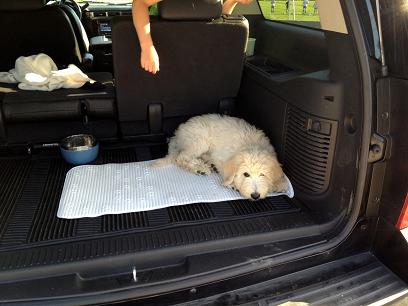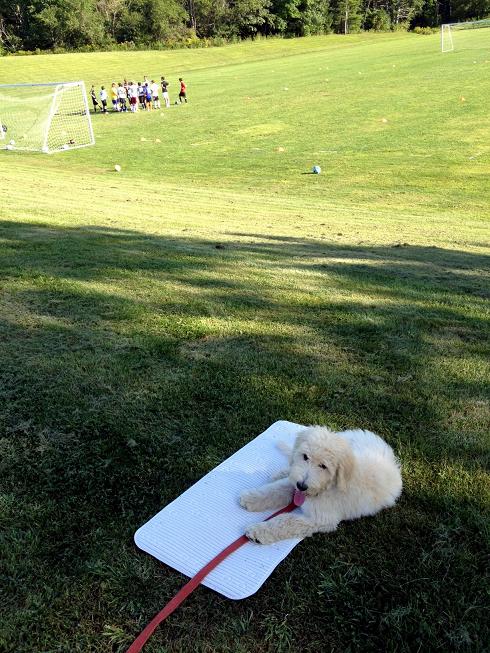 Author: Elsa Larsen, Dog Behaviorist & Trainer | Owner: My Wonderful Dog. Now that we've covered some of the things that may influence how you train in Part I, let’s talk about what to train.
Author: Elsa Larsen, Dog Behaviorist & Trainer | Owner: My Wonderful Dog. Now that we've covered some of the things that may influence how you train in Part I, let’s talk about what to train.
When I began my dog training career in 1997, I started out by training service dogs. A service dog is an animal that has been trained to assist his disabled partner with such specialized tasks such as picking up dropped items, finding lost keys or even reminding their partner to take their medications. It takes many months and hundreds of hours worth of training to teach the skills that a dog will need to become a service dog.
While most pet dog owners don’t require that level of training for their dog, I do believe that the average dog owner would like their dog to have the same kind of self-restraint that any person with a disability expects from his or her working dog.
Here is my list of the five most critical skills I would want any dog to learn.
- Default Sit: The very first thing I would teach any new canine charge is a default sit. I’ll be honest here - I’m not crazy about dogs that jump all over me. Not many people are - even the most enthusiastic dog lover. Bearing that in mind, I would start right away to teach my dog that it is more beneficial to sit rather than to jump. Sitting is incompatible with jumping. A dog simply cannot sit and jump at the same time.
To do this, I would first want to set the dog up so that he or she can’t make many (or preferably any) paws on people mistakes. I would make sure my dog was either on a leash or on a tether whenever new people were around. This takes the anxiety out of any human/dog interaction. It means that you no longer have to worry about whether your dog will jump on someone because she/he can’t.
 Next, I would begin the task of teaching the sit. I would want to make sure that I always had some very high value rewards on hand to help ensure that my dog will want to work with me even if there are exciting things happening all around him or her. Since my goal is to teach the dog to automatically sit whenever new people appear, I would refrain from telling or asking my dog to sit (he/she might not choose to respond anyway and I wouldn’t want to inadvertently teach my dog to ignore my commands) but rather allow the dog to explore his or her options. Each time the dog chose to sit, I would follow that sit with a tasty treat because I understand that any behavior that is rewarded should happen more often. You need to be patient during this process. It can take a bit of time before the dog figures out that it is the sitting that is getting him the tasty treats. Once my dog became more reliable about responding to each new person that came along with a sit, I would begin to work on teaching my dog or pup to maintain his or her sit for longer and longer periods of time.
Next, I would begin the task of teaching the sit. I would want to make sure that I always had some very high value rewards on hand to help ensure that my dog will want to work with me even if there are exciting things happening all around him or her. Since my goal is to teach the dog to automatically sit whenever new people appear, I would refrain from telling or asking my dog to sit (he/she might not choose to respond anyway and I wouldn’t want to inadvertently teach my dog to ignore my commands) but rather allow the dog to explore his or her options. Each time the dog chose to sit, I would follow that sit with a tasty treat because I understand that any behavior that is rewarded should happen more often. You need to be patient during this process. It can take a bit of time before the dog figures out that it is the sitting that is getting him the tasty treats. Once my dog became more reliable about responding to each new person that came along with a sit, I would begin to work on teaching my dog or pup to maintain his or her sit for longer and longer periods of time.
- Chill On a Mat: This is one of my favorite skills to teach. The idea is that you will be able to send your dog over to a portable mat (like a bath mat or towel) where he or she will lie down and remain until released. The little Goldendoodle pup (pictured above) is 16 weeks old and he is lying on his mat in the middle of a soccer field with a team playing in the distance. What the photo doesn’t show are the four other soccer teams on either side of him. He shows all of this skill at such a young age. What a good dog and what good parents he has to spend so much time teaching him how to behave in public places!
- Come: We all want our dogs to come when called but a lot of dogs that I work with just don’t. They are completely unreliable. You need to teach your dog that it is totally worth giving up whatever he or she is engaged with to come running to you. It is important to reinforce this behavior every time with a super tasty treat (if your dog is food motivated) or a game of tug (if your dog is play motivated).
If your dog isn’t reliable, work on this skill with your dog on a long leash and then inside an enclosed area before ever trusting him off leash. If your dog does NOT come when he or she is called, whatever you do, don’t nag him. Repeating commands is the quickest way to teach your dog to ignore you. Go and get her/him and go back to working with the dog on a line until he or she is more reliable.
- Eye Contact: Eye contact is a great way to teach your dog to keep his or her focus on you. I start this skill by rewarding my dog every time he or she chooses to look at me - on walks, at the dog park, when kids are around, in the house etc. I call these “check-ins”. Check-ins are a great way to start to teach your dog or pup that it pays to look.
- Leave It: Leave that alone! Don’t mess with it. The purpose of this skill is to teach your dog to back away and not to touch anything that you’ve asked him or her not to. The “it” in question could be a cat, a hamburger bun, a sock. Imagine how handy that would be!
In closing, remember to dedicate some time to training your dog or pup. It’s not fair to get angry with your dog for misbehaving if you haven’t taken the time to teach your dog what is expected of him or her. No matter which skills you find important for your dog to learn, understand that behaviors need to be rewarded often and well and you will need to limit your dogs opportunity to make the wrong choices by using better management—head halters or no pull harnesses for a dog who pulls, leashes and tethers for jumpers and long lines for a dog who won’t come when he or she is called. If you feel like you some additional help, you can search for a professional trainer in your area at www.apdt.com. Good luck!
About Elsa Larsen:
Elsa started her dog training career as a volunteer for an organization in Santa Rosa, California that trained dogs for people with disabilities. In June 2000, Elsa moved to the east coast and created My Wonderful Dog, a non profit that that engaged at risk youth in the care and training of service dogs. Sadly, the non profit had to close its doors in 2008 due to lack of funding, but under the original banner of My Wonderful Dog, Elsa continues to bring her expertise and knowledge to bear in her quest to create harmony between pet dogs and their owners in and around Portland, Maine and the greater Boston area. With over 15 years experience, Elsa has had the pleasure of working with hundreds of dogs on issues as diverse as dog aggression to puppy management and care.
To follow Elsa and My Wonderful Dog on Facebook, click here.